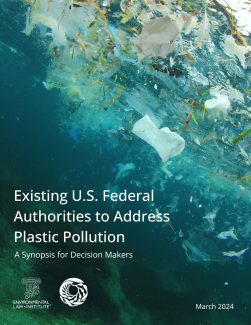Biodiversity, Health Concerns: Fostering Action on Plastic Waste

During a February hearing of a Senate Environment and Public Works subcommittee, Oregon State University assistant professor Susanne Brander testified that plastic pollution has emerged as “one of the greatest environmental challenges of the Anthropocene,” and one of the world’s most expensive problems. The economic costs to fishing, tourism, and shipping are estimated at $13 billion a year, she said, and human health costs at $249 billion. Plastics are also killing seabirds, turtles, seals, and other marine mammals, including endangered wildlife, according to the Center for Biological Diversity.
The hearing was the first in a series that subcommittee chair Senator Jeff Merkley (D-OR) is holding on how plastics are adversely impacting human and ecosystem health. In October, Merkley reintroduced his Break Free From Plastic Pollution Act, with 30 cosponsors and support from more than 200 organizations. Among its provisions, the bill would temporarily suspend permitting for new and expanded plastic production facilities pending new EPA regulations; require manufacturers to design, manage, and finance waste and recycling programs for their plastics products, in line with an emerging solution called “extended producer responsibility”; and ban specific single-use non-recyclable plastic products.
Whatever the prospects for Merkley’s bill, concerns are increasing about plastics pollution and its effects not only on biodiversity but also on human health. At the February hearing, Brander testified that harm to aquatic and terrestrial organisms from microplastics in water, generally less than 5 millimeters in size, have been “widely documented.” Early research on human impacts has found microplastics in the human heart, placenta, lung tissues, and blood, she added. In March, Greenwire reported that researchers had published the first-ever study to link micro- and nanoplastics with heart disease, stroke, and death in humans, adding to calls for action.
At a March full EPW committee hearing, World Wildlife Fund’s top official for plastics waste, Erin Simon, also cited the “staggering” amount of plastics pollution as among the biggest global environmental problems. Now found “everywhere,” plastic pollution is harming highly fragile ecosystems, with more than 2,000 species encountering plastic in their habitats. While microplastics’ “full impact” on human health is yet unknown, she said, research increasingly reveals a “real cause for concern,” a consensus Americans now “overwhelmingly” share. An upcoming WWF study finds that 85 percent of the public strongly or somewhat agree that “immediate political action” is needed to reduce plastic pollution.
H. Fisk Johnson, the CEO of consumer goods company SC Johnson, also testified that its own survey found 79 percent of Americans believe government should be “leading the way” in addressing the plastic waste problem. Currently, states are beginning to adopt inconsistent, conflicting regulations that will drive a “massive increase in complexity and costs” for producers, Johnson said. His company strongly supports federal “extended producer responsibility” regulations to create nationally consistent standards. Johnson lamented the “looming issue” of micro- and nanoplastics that society must “come to terms with,” either through EPR or other ways.
EPA is among the agencies trying to come to terms with the problem, through its National Strategy to Prevent Plastic Pollution, which drew almost a thousand public comments that the agency is now reviewing. In a letter to EPA, more than 60 members of Congress urged the agency to “promptly initiate rulemaking” under the Clean Water Act that reflects evidence of risks to human and marine life posed by plastic trash and microplastics entering waterways. The Department of the Interior, in its comments, called on EPA to consider expanding its strategy to include sea-based sources—specifically from the commercial fishing industry—that contribute significantly to plastic pollution impacting seabirds, fish, and marine mammals.
Another agency working on an aspect of the problem is the General Services Administration, which is weighing a regulatory proposal that would curb the federal government’s purchase of unnecessary “single-use plastic products and packaging,” a salient part of the broader plastic waste problem also targeted by Merkley’s bill and EPA’s strategy. To see ELI’s work on existing legal authorities to reduce plastic pollution throughout its life cycle, see page 62.
Obviously, the vast increase in plastics waste is offset by the many benefits the materials have brought to humans. Equally clear, however, as many comments on the issue concur, the entire “plastic ecosystem” must be involved in a multi-faceted, coordinated plan, including federal and state government, manufacturers, and consumers. But can a deeply divided American body politic carry off the required collaboration?
Biodiversity, Health Concerns: Fostering Action on Plastic Waste.




